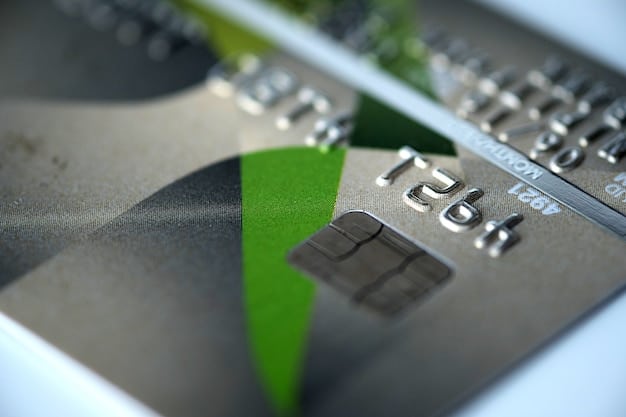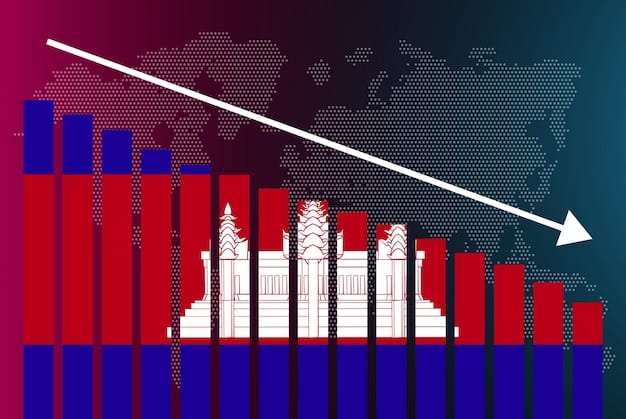Federal Reserve Rate Hikes & Your Credit Card Debt: Understanding the Impact

Understanding the potential impact of the Federal Reserve’s projected interest rate hikes on your credit card debt is crucial for consumers, as these hikes directly influence the interest rates charged on credit cards, potentially increasing debt burdens and affecting financial planning.
Navigating the world of personal finance can feel like a rollercoaster, especially when external factors like the Federal Reserve’s decisions come into play. Are you wondering how the Fed’s projected interest rate hikes might affect your credit card debt? Let’s delve into understanding the potential impact of the Federal Reserve’s projected interest rate hikes on your credit card debt and explore strategies to manage your finances effectively.
Understanding Federal Reserve Interest Rate Hikes
The Federal Reserve, often referred to as the Fed, plays a pivotal role in shaping the US economy. One of its key tools is adjusting the federal funds rate, which influences interest rates across various financial products, including credit cards. Understanding these rate hikes is essential for anyone managing credit card debt.
What is the Federal Funds Rate?
The federal funds rate is the target rate that the Federal Reserve wants banks to charge one another for the overnight lending of reserves. Changes to this rate ripple through the economy, affecting everything from mortgage rates to savings account yields.
How the Fed Influences Interest Rates
When the Fed raises the federal funds rate, it becomes more expensive for banks to borrow money. These increased costs are often passed on to consumers in the form of higher interest rates on loans and credit cards. Conversely, when the Fed lowers rates, borrowing becomes cheaper.

Understanding how these adjustments impact credit card interest rates can lead to better financial planning. Consider these points:
- Variable vs. Fixed Rates: Most credit cards have variable interest rates tied to a benchmark, often the prime rate, which closely follows the federal funds rate.
- Timing of Impact: The impact isn’t immediate. It usually takes one to two billing cycles for rate changes to reflect on your credit card statement.
- Long-Term Implications: Over time, even small rate increases can significantly increase the total interest paid on outstanding balances.
In summary, Federal Reserve interest rate hikes are a crucial economic lever that directly affects the interest rates consumers pay on their credit cards. Monitoring these changes is vital for informed financial management.
The Direct Impact on Credit Card Interest Rates
The most immediate consequence of a Federal Reserve rate hike is the increase in Annual Percentage Rates (APRs) on credit cards. For many consumers, this means paying more in interest charges, potentially leading to a longer and more expensive debt repayment journey.
How APRs are Affected
Credit card APRs are typically variable rates, meaning they fluctuate with a benchmark rate. When the Fed raises rates, this benchmark increases, and credit card companies adjust their APRs accordingly. The increase is usually proportional to the Fed’s hike.
Impact on Minimum Payments
Higher interest rates can also impact your minimum payments. A larger portion of each payment goes towards covering interest, leaving less to reduce the principal balance. This can prolong the time it takes to pay off the debt and increase the overall cost.
Consider these practical consequences:
- Increased Interest Charges: Each month, you’ll accrue more interest on your outstanding balance.
- Slower Debt Payoff: With more of your payment going towards interest, it takes longer to reduce your debt.
- Higher Total Cost: Over the life of the debt, you’ll pay significantly more in interest charges.
Essentially, Federal Reserve rate hikes lead to higher APRs on credit cards, impacting minimum payments and increasing the total cost of borrowing, thus making it more difficult to manage credit card debt.
Strategies to Mitigate the Impact
While Federal Reserve rate hikes can seem daunting, there are several strategies you can employ to mitigate their impact on your credit card debt. Being proactive and making smart financial decisions can help you stay ahead of rising interest rates.
Balance Transfers
One popular strategy is transferring your balance to a credit card with a lower promotional interest rate. This can provide temporary relief from high APRs, giving you a window to pay down your balance more efficiently.
Debt Consolidation Loans
Another option is to consolidate your credit card debt into a personal loan with a fixed interest rate. This can help you lock in a lower rate and create a predictable payment schedule.

Here are some practical steps to take:
- Negotiate with Your Credit Card Company: Call your credit card issuer and ask for a lower interest rate.
- Create a Budget: Track your spending and identify areas where you can cut back to allocate more funds towards debt repayment.
- Explore Debt Management Plans: Consider working with a credit counseling agency to develop a debt management plan tailored to your needs.
In summary, mitigating the impact of Federal Reserve rate hikes involves strategies such as balance transfers, debt consolidation loans, negotiating with creditors, and creating a budget to manage and reduce credit card debt effectively.
Refinancing and Consolidation Options
Exploring refinancing and consolidation options can provide significant relief from the burden of high credit card interest rates. These strategies involve replacing your existing debt with a new loan or credit line, ideally at a lower interest rate.
Credit Card Balance Transfers
A credit card balance transfer involves moving your existing credit card debt to a new credit card that offers a lower introductory APR. This promotional period can last anywhere from 6 to 24 months, providing a window to pay down your debt more efficiently.
Personal Loans for Debt Consolidation
Personal loans can be used to consolidate various debts, including credit card balances. These loans typically offer fixed interest rates and repayment terms, providing stability and predictability in your debt repayment efforts.
Key considerations when evaluating these options:
- Compare APRs: Shop around for the lowest interest rates available on balance transfer cards and personal loans.
- Assess Fees: Be aware of any balance transfer fees, origination fees, or prepayment penalties associated with these options.
- Check Credit Score Requirements: Most balance transfer cards and personal loans require a good to excellent credit score for approval.
In essence, refinancing and consolidation options, such as balance transfers and personal loans, offer viable paths to reducing credit card interest rates and simplifying debt repayment, but careful evaluation of APRs, fees, and credit score requirements is essential.
Budgeting and Spending Adjustments
One of the most effective ways to manage the impact of Federal Reserve rate hikes on your credit card debt is to create a budget and make necessary adjustments to your spending habits. This proactive approach empowers you to take control of your finances and reduce reliance on credit.
Creating a Realistic Budget
Start by tracking your income and expenses to understand where your money is going each month. Identify areas where you can cut back and reallocate funds towards debt repayment.
Reducing Discretionary Spending
Look at your discretionary spending, such as dining out, entertainment, and non-essential purchases. Reducing these expenses can free up additional funds to pay down your credit card debt.
Practical steps to improve budgeting and spending:
- Use Budgeting Apps: Utilize budgeting apps to track your spending and set financial goals.
- Automate Savings: Set up automatic transfers to a savings account each month to build an emergency fund.
- Meal Prep: Reduce dining out expenses by preparing meals at home.
In conclusion, budgeting and making strategic spending adjustments are critical for managing the impact of Federal Reserve rate hikes on credit card debt, enabling you to reduce reliance on credit and accelerate debt repayment through proactive financial planning.
Long-Term Financial Planning
Addressing the impact of Federal Reserve rate hikes on credit card debt requires more than just short-term fixes. Long-term financial planning is essential for building a solid foundation and securing your financial future. Thinking beyond the immediate challenges can empower you to make wiser decisions and avoid the pitfalls of debt.
Building an Emergency Fund
An emergency fund provides a safety net to cover unexpected expenses, such as medical bills or job loss, without relying on credit cards. Aim to save at least 3-6 months’ worth of living expenses in a readily accessible account.
Investing for the Future
Once you’ve established an emergency fund, consider investing for long-term goals, such as retirement or your children’s education. Diversifying your investments can help you grow your wealth over time.
Key aspects of long-term financial planning:
- Consult a Financial Advisor: Seek professional guidance from a financial advisor to create a personalized financial plan.
- Regularly Review and Adjust Your Plan: Periodically review your financial plan and make adjustments as needed to align with your changing circumstances.
- Stay Informed: Keep up-to-date with financial news and trends to make informed decisions.
Essentially, long-term financial planning is vital for mitigating the impact of Federal Reserve rate hikes on credit card debt, providing resilience, avoiding excessive debt, and fostering a secure financial future through emergency funds, diversified investments, and informed decision-making.
| Key Point | Brief Description |
|---|---|
| 📈 Rate Hikes | Fed rate hikes increase credit card APRs. |
| 💳 Balance Transfers | Move debt to a card with a lower promotional rate. |
| 💰 Budgeting | Track spending and reduce non-essential expenses. |
| 🛡️ Emergency Fund | Build a fund to avoid credit card reliance for unexpected costs. |
FAQ
▼
When the Federal Reserve raises interest rates, credit card companies typically increase their APRs, making borrowing more expensive and increasing the amount you pay in interest charges.
▼
A balance transfer involves moving your existing credit card debt to a new card with a lower promotional APR. This can help you save money on interest and pay down your debt faster.
▼
Debt consolidation involves taking out a new loan to pay off multiple debts, simplifying repayment. It’s a good option if you can secure a lower interest rate than your current debts.
▼
Budgeting helps you track your income and expenses, identify areas to cut back, and allocate more funds towards debt repayment, giving you greater control over your finances.
▼
An emergency fund is a savings account for unexpected expenses. It’s crucial because it prevents you from relying on credit cards when emergencies arise, avoiding further debt accumulation.
Conclusion
In conclusion, understanding the potential impact of the Federal Reserve’s projected interest rate hikes on your credit card debt is crucial for maintaining financial stability. By staying informed, implementing proactive strategies like balance transfers and budgeting, and focusing on long-term financial planning, you can navigate these challenges effectively and work towards a secure financial future.





